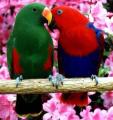Parrots' colour scheme is a real cracker
Monday, August 08 2005 @ 06:00 AM UTC
Contributed by: MikeSchindlinger
 By Deborah Smith Science Editor
By Deborah Smith Science Editor
July 23, 2005
Now the puzzle of the unique colour scheme of the Australian eclectus parrot has been solved in an eight-year study by researchers who climbed tall rainforest trees to observe them in their nests.
Robert Heinsohn, of the Australian National University, said the males and females were so different-looking they were originally mistaken as separate species. "There is no other bird like it," he said.
In the avian world, females who stay near the nest raising the young are usually dull-coloured and well camouflaged, while males have evolved spectacular flashy colours, such as the peacock's spectacular tail, to attract sexual partners or repel rivals.
In a few cases of gender role reversal, such as the button quail, the males guard the nest and are smaller and less colourful than the females.
However, the parrot Eclectus roratus, which inhabits far north Queensland, fits neither of these categories.
AdvertisementAdvertisement
Dr Heinsohn and his colleagues spent more than six months a year living in a shack at the tip of Cape York. Their results were published yesterday in the journal Science.
They used ropes to reach the birds' nests in tree hollows.
The team found females spent up to 11 months a year defending them, sometimes fighting to the death, he said.
They also analysed how the birds' colours appeared to other parrots and to their predators, hawks, which have eyes that are less sensitive to ultraviolet light.
This revealed the male parrots' green provides good camouflage from hawks when foraging in the rainforest canopy, but the males' plumage has a bright ultraviolet component that makes them conspicuous to other parrots plotting to attack their nests.
"The females' red turns out to be very bright to humans' eyes, parrot eyes and hawk eyes," Dr Heinsohn said. "But they have the safety of the hollow, somewhere to retreat."
The study showed bright colours could evolve independently in each gender when their lifestyles were very different, he said.
Logging was being considered in the rainforest where Australia's small population of about 2000 eclectus parrots lived.
If any of their nest trees were cut down, their numbers "would spiral downwards and they could go extinct", Dr Heinsohn said.
http://www.smh.com.au/news/national/parrots-colour-scheme-is-a-real-cracker/2005/07/22/1121539154833.html?oneclick=true
0 comments
http://www.freeparrots.net/article.php?story=2005080806004687
 By Deborah Smith Science Editor
By Deborah Smith Science Editor